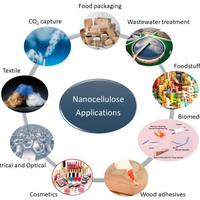MA Asrofi
University of Jember, Mechanical Engineering, Faculty Member
- Universitas Andalas, Mechanical Engineering, Graduate Studentadd
This paper characterizes properties of biocomposite sonicated during gelatinization. The biocompos-ite consisted of tapioca starch based plastic reinforced by 10% volume fraction of water hyacinth fiber (WHF). During gelatinization, the... more
This paper characterizes properties of biocomposite sonicated during gelatinization. The biocompos-ite consisted of tapioca starch based plastic reinforced by 10% volume fraction of water hyacinth fiber (WHF). During gelatinization, the biocomposite was poured into a rectangular glass mold then vibrated in an ultrasonic bath using 40 kHz, 250 W for varying durations (0, 15, 30, and 60 min). The resulting biocomposite was then dried in a drying oven at 50 • C for 20 h. The results of this study indicate that a biocomposite with optimal properties can be produced using tapioca starch and WHF if the gelatinizing mixture is exposed to ultrasound vibration for 30 min. After this vibration duration, tensile strength (TS) and tensile modulus (TM) increased 83% and 108%. A further 60 min vibration only increased the TS at 13% and TM at 23%. Moisture resistance of the biocomposite after vibration increased by around 25% reaching a maximal level after 30 min. Thermal resistance of the vibrated biocomposites was also increased.
Research Interests:
The isolation and characterization of nanocrystalline cellulose (NCC) from water hyacinth (WH) fibers were carried out. There are two treatments to obtain NCC from WH fibers by chemical and mechanical treatments. The chemical treatment... more
The isolation and characterization of nanocrystalline cellulose (NCC) from water hyacinth (WH) fibers were carried out. There are two treatments to obtain NCC from WH fibers by chemical and mechanical treatments. The chemical treatment involved alkalization with NaOH 25% in a highly-pressured tube, acid hydrolysis with 5M HCl, and bleaching with (NaClO 2 :CH 3 COOH) in ratio 5:2. The mechanical treatment was performed by using ultrasonic homogenizing at 12000 Rpm for 2 h. The morphological surface was observed by Transmission Electron Microscopy (TEM). TEM reported that the size of NCC was 10–40 nm. Crystallinity index and functional group analysis of the NCC WH fibers were also examined using X-Ray Diffraction (XRD) and Fourier Transform Infrared Spectroscopy (FTIR) techniques. XRD reported that the crystallinity index increased significantly after chemical and mechanical treatment due to the presents of crystalline area in the WH fibers. The crystallinity index of raw fiber, digester, bleaching, and ultrasonic homogenizing were 7%, 68%, 69%, and 73% respectively. The content cellulose of final product was 68% as measured by the chemical composition test. Meanwhile, FTIR reported that WH fibers after being given chemical treatment lead the functional group change due to removal hemicellulose and lignin. The result of XRD and FTIR were indicated that the sample of NCC WH fibers presents the structure of cellulose crystal type I.
Research Interests:
In this study, the effect of mechanical treatment on the characterization of microfibrillated cellulose (MFC) from water hyacinth pulp was carried out. Chemical and mechanical treatments were used in this experiments. Chemical treatment... more
In this study, the effect of mechanical treatment on the characterization of microfibrillated cellulose (MFC) from water hyacinth pulp was carried out. Chemical and mechanical treatments were used in this experiments. Chemical treatment such as cooking fibers into the high pressure reactor.While, the mechanical treatment that provides shear stress on the fibers by means of the wet blending process. The experiments were conducted at the time of wet blending namely 15, 20, and 25 min respectively. The final products were characterized by using scanning electron microscopy (SEM), X-ray diffraction (XRD), and tensile test. SEM observation was carried out on the surface of the film. XRD shows that the crystallinity index of MFC with wet blending 15, 20, and 25 min are 56.24, 78.41, and 85.97% respectively. The maximum value of tensile strength was 23.21 MPa at 25 min of wet blending.
